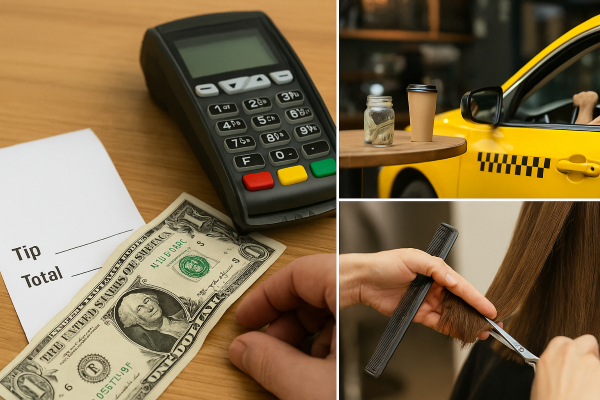OBBBA: “No Tax on Tips”
— What Actually Changes
Short version
OBBBA adds a temporary, targeted deduction for tips. It’s not a universal “no tax on tips.” Many tipped amounts are still taxable, and payroll taxes still apply. Here’s the clean, CFO-level breakdown you can put in front of clients.

Who can claim the deduction
For tax years 2025 through 2028, the tips deduction is available to:
- Employees in occupations that customarily and regularly received tips before 2025, and
- Self-employed individuals in those same occupations,
- Provided they have a work-eligible Social Security number and, if married, file jointly.
The IRS is publishing a qualifying-occupations list. Examples likely to qualify:
- Restaurants: servers, bartenders, hosts, food runners, counter staff; in some states, kitchen workers who participate in valid tip pools
- Hospitality: bellhops, valets, concierges, housekeeping, doormen
- Personal care: hairstylists, barbers, nail techs, tattoo artists, body/spa workers, massage therapists
- Transportation: taxi and rideshare drivers; delivery drivers
- Other services: baristas, dog groomers, casino dealers, golf caddies, tour guides
Not eligible: workers in SSTBs for QBI purposes and employees of SSTB employers, including health, law, accounting, performing arts, athletics, consulting, financial advisory, investment/wealth management, actuarial, and trading services. In short: professionals can’t convert fees to “tips” to grab an extra deduction.
What counts as a “tip”
Included: cash or charged amounts that are:
- received directly from customers or through a valid tip-sharing arrangement,
- voluntary (no consequence if not paid), and
- determined by the customer (not negotiated).
Not included: employer‑mandated service charges or “auto‑gratuities” such as large‑party fees, bottle‑service fees, room‑service charges, contracted luggage fees, or mandatory delivery charges. Those are wages/fees, not tips.
How the deduction works
- Annual cap: up to $25,000 per taxpayer.
- Self-employed limit: deduction cannot exceed net income from the business that earned the tips (computed before the tips deduction).
- Income phaseout: begins at MAGI $150,000 single($300,000 joint) and phases out by $400,000 single ($550,000 joint).
- Tax affected: federal income tax only. Social Security and Medicare taxes are unchanged.
- Location on return: below-the-line deduction; available whether or not the taxpayer itemizes.
Example:
Mario, a Manhattan server, earns $31,680 in wages and$60,000 in tips (2025). Mario deducts $25,000 of tips. At a 22% marginal rate, that saves $5,500 of federal income tax. Payroll taxes stay the same.
Reporting rules that matter
Employees
- Must report cash tips of $20+ in any month to their employer. Only reported tips are eligible for the deduction.
- 2025: employers keep withholding income and payroll taxes as usual; employees claim the deduction on the 2025 Form 1040.
- 2026–2028: IRS will adjust withholding tables so paychecks reflect the deduction during the year.
- Employers will also report total employee tips and occupation codes on wage statements; the IRS is revising Form W‑2accordingly.
Self‑employed
- May not always receive Forms 1099‑NEC or 1099‑Kreflecting tips. Beginning 2026, expect more precise third‑party reporting of eligible cash tips and occupation.
- 1099 thresholds (as relevant): from 2026, Form1099‑NEC has a $2,000 annual threshold; Form 1099‑K generally applies only when >200 transactions and >$20,000 in payments.
- Unreported tips still belong on Schedule C; keep contemporaneous records.
Platforms and third‑party payors (from 2026)
Employers, payment processors, and platforms must separately report cash tips eligible for the deduction and identify the recipient’s occupation on the appropriate form (W‑2, 1099‑NEC, or 1099‑K).
Coordination with other deductions
QBI interaction: any tips you deduct here cannot also count toward the QBI (§199A) deduction. For instance, if a self‑employed stylist deducts $20,000 of tips under OBBBA, that $20,000 does not feed into QBI.
Practical guardrails and planning notes
- This is a temporary benefit (2025–2028). Don’t build long‑term compensation models around it.
- Payroll taxes do not change. Expect no savings on Social Security or Medicare from this provision.
- Only about 2.5% of U.S. workers are in tip‑reliant occupations. For many, the income tax value will be modest. For high‑tip earners under the phaseout thresholds, the $25,000 cap is meaningful.
- Recordkeeping drives eligibility. Report tips accurately, track tip‑pool policies, and keep daily logs.
- Married taxpayers must file jointly to claim the deduction.
Quick compliance checklist (2025 filing season)
- Validate the worker’s occupation falls on the IRS “customarily tipped” list
- Confirm SSN eligibility and, if married, joint filing
- Ensure tips were reported to the employer(employees) or are logged contemporaneously (self‑employed)
- Apply the $25,000 cap and MAGI phaseout rules
- Exclude OBBBA‑deducted tips from QBI
- Treat service charges as non‑tip wages/fees
- Withhold and deposit payroll taxes normally
Bottom line
OBBBA’s “no tax on tips” is branding, not a blank exemption. Qualified workers can deduct up to $25,000 of eligible tips from income tax for 2025–2028, subject to phaseouts and strict definitions. Payroll taxes remain. Documentation wins the day.
Disclaimer: This summary is for general guidance only and isn’t tax, legal, or accounting advice. Implementation details evolve with IRS guidance; confirm current forms, thresholds, and definitions at filing time.
Closing Note:
We’re here to keep your business sharp, your taxes optimized, and your future protected. If you’d like to see whether this strategy fits your situation, reach out today. 855-922-WeDo (9336)
